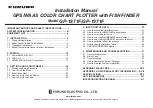
1. INSTALLATION
6
Installation procedure
1. With the boat hauled out of the water, mark the location chosen for mounting the
transducer on the bottom of the hull.
2. If the hull is not level within 15° in any direction, fairing blocks made out of teak
should be used between the transducer and hull, both inside and outside, to keep
the transducer face parallel with the water line. Fabricate the fairing block as
shown below and make the entire surface as smooth as possible to provide an un-
disturbed flow of water around the transducer. The fairing block should be smaller
than the transducer itself to provide a channel to divert turbulent water around the
sides of the transducer rather than over its face.
3. Drill a hole just large enough to pass the threaded stuffing tube of the transducer
through the hull, making sure it is drilled vertically.
4. Apply a sufficient amount of high quality caulking compound to the top surface of
the transducer, around the threads of the stuffing tube and inside the mounting
hole (and fairing blocks if used) to ensure watertight mounting.
5. Mount the transducer and fairing blocks and tighten the locknut. Be sure that the
transducer is properly oriented and its working face is parallel to the waterline.
Note:
Do not over-stress the stuffing tube and locknut through excessive tightening,
since the wood block will swell when the boat is placed in the water. It is suggested
that the nut be tightened lightly at installation and re-tightened several days after the
boat has been launched.
Transducer preparation
Before putting your boat in water, wipe the face of the transducer thoroughly with a
detergent liquid soap. This will lessen the time necessary for the transducer to have
good contact with the water. Otherwise the time required for complete "saturation" will
be lengthened and performance will be reduced.
DO NOT
paint the transducer. Performance will be affected.
Hole for
stuffing tube
Saw along
slope of hull.
Upper Half
Lower Half
BOW
Deep-V Hull
Flat Washer
Rubber Washer
Fairing
Block
Hull
Flat Hull
Hull
Flat Washer
Rubber
Washer
Cork
Washer
1. INSTALLATION
7
1.3.2
Transom mount transducer
The optional transom mount transducer is very commonly employed, usually on rela-
tively small I/O or outboard boats. Do not use this method on an inboard motor boat
because turbulence is created by the propeller ahead of the transducer.
DO NOT over-tighten screws, to prevent damage to the transducer.
Installation procedure
A suitable mounting location is at least 50 cm away from the engine and where the
water flow is smooth.
1. Drill four pilot holes for self-tapping screw (
I
5
u
20) in the mounting location.
2. Coat the threads of the screws (M5x14) for the transducer with marine sealant for
waterproofing. Attach the transducer to the mounting location with the self-tapping
screws.
3. Adjust the transducer position so the transducer faces right to the bottom. If nec-
essary, to improve water flow and minimize air bubbles staying on the transducer
face, incline the transducer about 5° at the rear. This may require a certain amount
of experimentation for fine tuning at high cruising speeds.
4. Tape the location shown in the figure below.
5. Fill the gap between the wedge front of the transducer and transom with epoxy
material to eliminate any air spaces.
6. After the epoxy hardens, remove the tape.
Transom
Parallel with hull
Less than 10°
Less than 10°
Transom
Strake
Mount at the strake.
Over 10°
ø5x20
M5x14
5°
Taping
Bracket
Transducer
2 to 5
°
Epoxy material
Hull






















